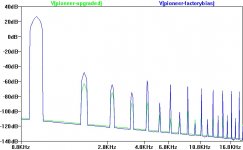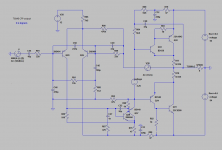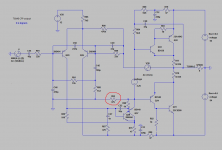Member
Joined 2009
Paid Member
I think there's something to learn from these low cost products - your quite right about the 'cheap' board and parts. But, it does a credible job for sure. I shall get my head out of it - other things to play with...
I have no experience of other Sunken devices but I have a great respect for the quality of their parts, Darlington or not. Even the Darlington parts look to have excellent performance for what they are. They are plenty fast enough for a good quality amplifier. I would not shun them for being Darlington devices.
I have no experience of other Sunken devices but I have a great respect for the quality of their parts, Darlington or not. Even the Darlington parts look to have excellent performance for what they are. They are plenty fast enough for a good quality amplifier. I would not shun them for being Darlington devices.
Member
Joined 2009
Paid Member
I had the system in action for the first time since making the modifications, yesterday evening. I started with the built-in FM tuner. Stronger bass was the first thing I noticed, and then an overall satisfying sound. I use PMC speakers, floorstanders for L & R mains and a smaller unit for C.
After using the FM tuner tried it on a Bluray video (a Star Trek episode) - sound was clearer, however it was not as good as the FM tuner. Perhaps for HT use there is a trade-off between having an amplifier that is clean and punchy verses an amplifier that can hide deficiencies in less-than-perfect video sound tracks. To that end, the simple mod I made appears to have been just the right thing but I will know better after more listening.
After using the FM tuner tried it on a Bluray video (a Star Trek episode) - sound was clearer, however it was not as good as the FM tuner. Perhaps for HT use there is a trade-off between having an amplifier that is clean and punchy verses an amplifier that can hide deficiencies in less-than-perfect video sound tracks. To that end, the simple mod I made appears to have been just the right thing but I will know better after more listening.
Last edited:
I think that will depend on your criterion for Darlingtons. AFAIK, Sanken is the only significant manufacturer in the field of audio specified Darlingtons, whether they have thermal compensation diodes on-chip or not.Sanken Darlington outputs are the best Darlingtons.
Sanken have had their reliability problems though, as shown in the scrapping of the SAP product line and introduction of the STD03 replacements, which eliminate the troublesome on-chip emitter resistor.
Some of the other contenders for Darlington status may "work" fine but their performance as complementary output devices is a long way from that of modern discrete parts intended for high quality audio
Member
Joined 2009
Paid Member
Fortunately there is a thread specifically for this topic - Darlington outputs - which you guys might find interesting and your ideas and information would add further to that discussion. http://www.diyaudio.com/forums/soli...ple-dont-use-darlington-power-transistor.html
Good thing about TGM6 - it sounds just fine with Sanken Darlington outputs and I would be happy to use them again based on this experience. And a recommendation from Jan gets a good share of the vote.
Good thing about TGM6 - it sounds just fine with Sanken Darlington outputs and I would be happy to use them again based on this experience. And a recommendation from Jan gets a good share of the vote.
I red first 5 pages of that thread and I lost interest in further reading. I know for sure that good amplifiers could be made with Darlingtons, especially Sanken Darlingtons. The loss of performance compared to discrete configuration will be more than compensated with their practicality.
Maybe you right ivanlukic, but one thing I would like to do is build an amplifier with Darlington output transistors and an EF pre-driver stage behind it. An EF3 but with fewer physical parts than a traditional design. It might prove easier to stabilise the thing since the output transistor and its "driver" are all contained within a single package minimising lead inductance (or the exact opposite may be true).
The high fT of these and other Sanken products point to the tantalising possibility of high a very high ULGF and resulting low distortion with simple compensation and relatively few parts. In short I'm not dismissive of this avenue of exploration.
The high fT of these and other Sanken products point to the tantalising possibility of high a very high ULGF and resulting low distortion with simple compensation and relatively few parts. In short I'm not dismissive of this avenue of exploration.
Hi Ranchu,
Look at National Semiconductor AN-1490. What they specified for LM4702 front end IC? Sanken Darlingtons MN2488 and MP1620! The easiest way to achieve excellent results. Of course, if one uses LM4702 front end IC there will be no pleasure of designing your own amp, but excellent results are almost guaranteed. I suggest reading AN-1490, some nice pointers there.
Look at National Semiconductor AN-1490. What they specified for LM4702 front end IC? Sanken Darlingtons MN2488 and MP1620! The easiest way to achieve excellent results. Of course, if one uses LM4702 front end IC there will be no pleasure of designing your own amp, but excellent results are almost guaranteed. I suggest reading AN-1490, some nice pointers there.
Last edited:
Member
Joined 2009
Paid Member
As I have some of these Sanken Darlingtons, the type used in the Pioneer amplifier, it would be really handy if we had a proper Spice model ?
I've resorted to a discrete Darlington for my spice modelling of this circuit. I've attached the file.
Also posted up is the FFT profile showing the 'before' and 'after' of my upgrade. The THD drops from a low number to a lower number - mostly besides the point, what I like is the drop in higher order harmonics (the 5th is already 100dB below the signal). But without proper device models it's a bit iffy.
I've resorted to a discrete Darlington for my spice modelling of this circuit. I've attached the file.
Also posted up is the FFT profile showing the 'before' and 'after' of my upgrade. The THD drops from a low number to a lower number - mostly besides the point, what I like is the drop in higher order harmonics (the 5th is already 100dB below the signal). But without proper device models it's a bit iffy.
Attachments
Member
Joined 2009
Paid Member
Member
Joined 2009
Paid Member
Member
Joined 2009
Paid Member
Wow, never heard of someone modding a HT receiver like that! Cool!
Yeah, the comment on the cost, internal designs - don't expect to see something that looks like a Pass Labs amp inside! They need to be cheap, light, and easy to make. And like was also said, some of the stuff in the $500-1000 range is shockingly good for what it is.
Having sold HT receivers for years and years, not a component setup for a long life. Tons of parts shoved in a small box, and those parts are generally pushed fairly hard to maximize the performance per dollar.
I think there is a good case for buying separates if you can make the leap. Get a new or used 5-7 channel amp (or a mix of things, at least a beefy amp for the front three, maybe a weaker amp for the rears) which you will keep forever (or will be able to sell if you want to upgrade), and get something like the Marantz AV7706 which will have all the tech, and you can either keep it for 5-10 years, or sell it for a decent price in a few years if you want to upgrade. Big up-front investment, but likely 'cheaper' in the very long run. Point is, if I was ready to spend upwards of $2-3k on a HT receiver, I would see if I could push for separates.
Yeah, the comment on the cost, internal designs - don't expect to see something that looks like a Pass Labs amp inside! They need to be cheap, light, and easy to make. And like was also said, some of the stuff in the $500-1000 range is shockingly good for what it is.
Having sold HT receivers for years and years, not a component setup for a long life. Tons of parts shoved in a small box, and those parts are generally pushed fairly hard to maximize the performance per dollar.
I think there is a good case for buying separates if you can make the leap. Get a new or used 5-7 channel amp (or a mix of things, at least a beefy amp for the front three, maybe a weaker amp for the rears) which you will keep forever (or will be able to sell if you want to upgrade), and get something like the Marantz AV7706 which will have all the tech, and you can either keep it for 5-10 years, or sell it for a decent price in a few years if you want to upgrade. Big up-front investment, but likely 'cheaper' in the very long run. Point is, if I was ready to spend upwards of $2-3k on a HT receiver, I would see if I could push for separates.
Member
Joined 2009
Paid Member
A system based on separates was my original aim. I remember being impressed with the analogue outputs of the Sony blu-ray player. Given that this quality came at relatively low cost, the idea of dropping thousands of dollars on a pre-amp just didn’t sit right. Looking at the Marantz you quoted, it’s clearly a gorgeous unit. It’s new, latest stuff and it does everything. It has more connectors on the back than a 1970’s telephone exchange. But it's still too darn expensive to get me to reach for my wallet on first sight, but interesting enough to tale a further look!
I also wonder if there enough decent quality source material, remembering that most movie audio uses lossy compression. However, things are improving as more people get high speed internet there is a market demand and Netflix has been improving their streaming bitrate.
I also wonder if there enough decent quality source material, remembering that most movie audio uses lossy compression. However, things are improving as more people get high speed internet there is a market demand and Netflix has been improving their streaming bitrate.
Last edited:
- Home
- Amplifiers
- Solid State
- TGM6 - modified Pioneer HT amplifier


